Civil Service Fast Stream: Cloud Computing Data Storage System Project
VerifiedAdded on 2021/05/31
|18
|1961
|74
Project
AI Summary
This project plan outlines the design and development of a cloud computing data storage system for the civil service fast stream in the United Kingdom. The project aims to improve data storage capacity, security, and accessibility for applicants. It includes a detailed scope statement, business case, and project objectives. The plan covers deliverables, project priorities, milestones, technical requirements, and risk management strategies. A work breakdown structure (WBS), Gantt chart, and critical path analysis are provided to illustrate project timelines and dependencies. The risk management section identifies potential risks such as system collapse and technology changes, along with mitigation measures. The project also includes a comprehensive budget and communication plan to ensure effective stakeholder management and project execution.
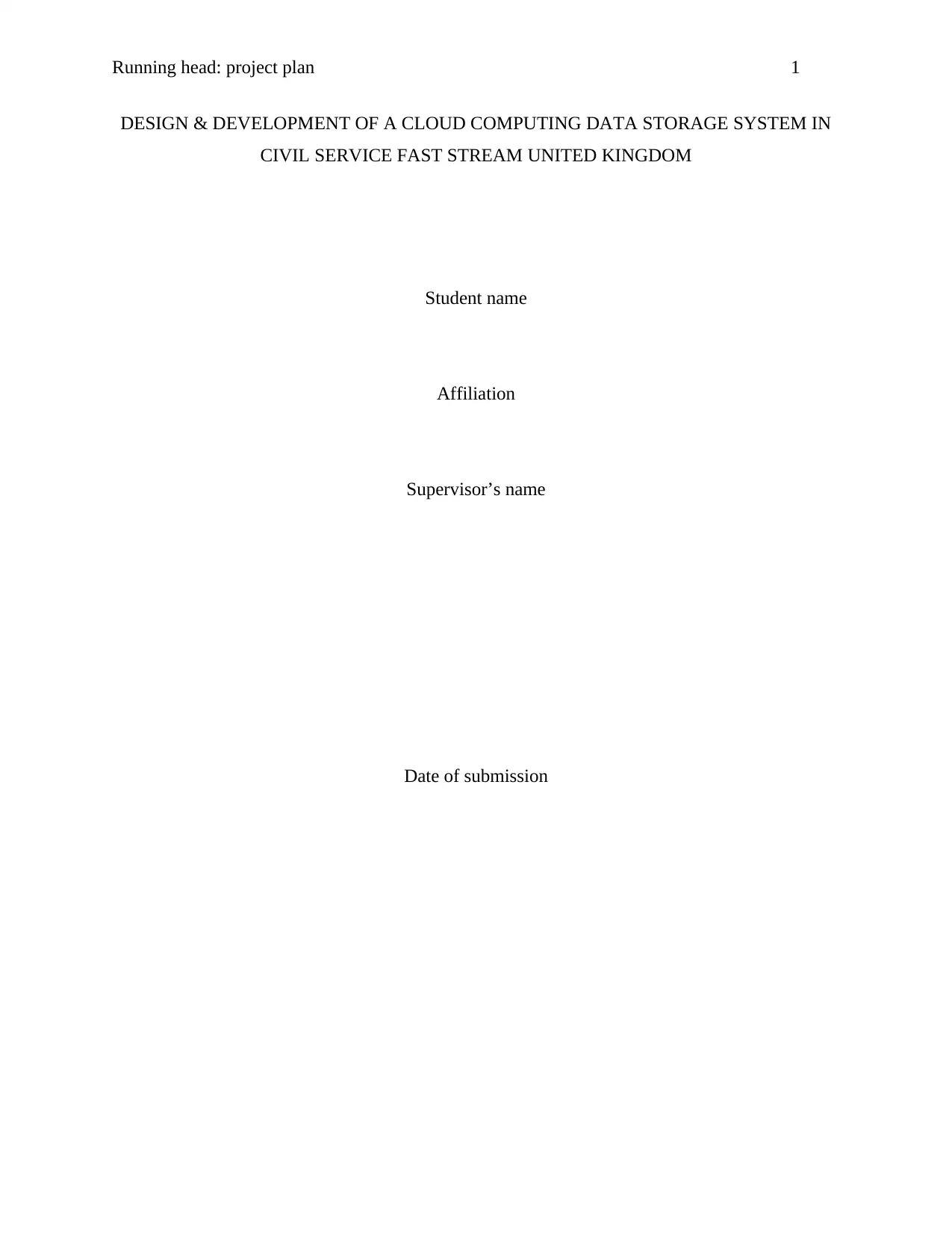
Running head: project plan 1
DESIGN & DEVELOPMENT OF A CLOUD COMPUTING DATA STORAGE SYSTEM IN
CIVIL SERVICE FAST STREAM UNITED KINGDOM
Student name
Affiliation
Supervisor’s name
Date of submission
DESIGN & DEVELOPMENT OF A CLOUD COMPUTING DATA STORAGE SYSTEM IN
CIVIL SERVICE FAST STREAM UNITED KINGDOM
Student name
Affiliation
Supervisor’s name
Date of submission
Paraphrase This Document
Need a fresh take? Get an instant paraphrase of this document with our AI Paraphraser
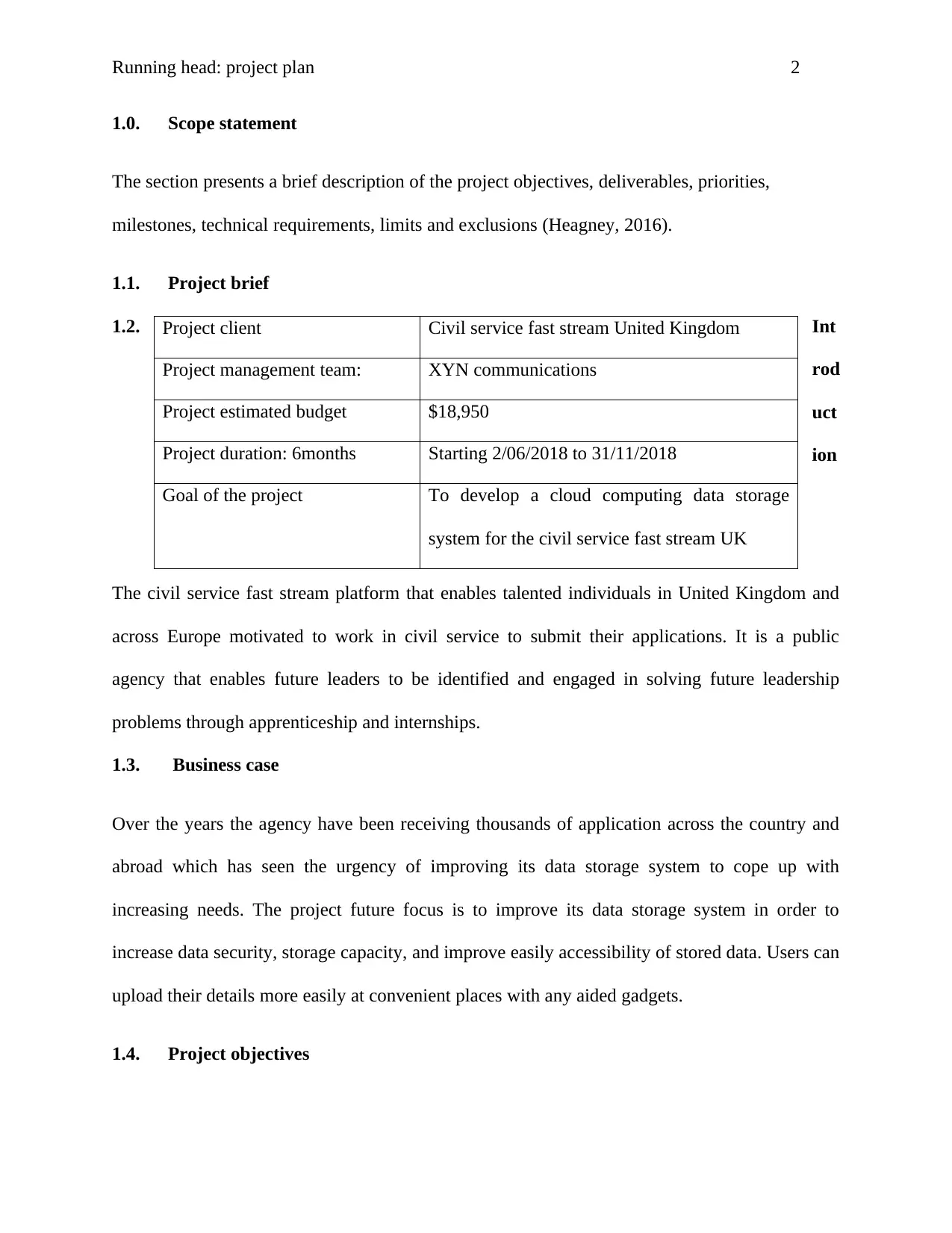
Running head: project plan 2
1.0. Scope statement
The section presents a brief description of the project objectives, deliverables, priorities,
milestones, technical requirements, limits and exclusions (Heagney, 2016).
1.1. Project brief
1.2. Int
rod
uct
ion
The civil service fast stream platform that enables talented individuals in United Kingdom and
across Europe motivated to work in civil service to submit their applications. It is a public
agency that enables future leaders to be identified and engaged in solving future leadership
problems through apprenticeship and internships.
1.3. Business case
Over the years the agency have been receiving thousands of application across the country and
abroad which has seen the urgency of improving its data storage system to cope up with
increasing needs. The project future focus is to improve its data storage system in order to
increase data security, storage capacity, and improve easily accessibility of stored data. Users can
upload their details more easily at convenient places with any aided gadgets.
1.4. Project objectives
Project client Civil service fast stream United Kingdom
Project management team: XYN communications
Project estimated budget $18,950
Project duration: 6months Starting 2/06/2018 to 31/11/2018
Goal of the project To develop a cloud computing data storage
system for the civil service fast stream UK
1.0. Scope statement
The section presents a brief description of the project objectives, deliverables, priorities,
milestones, technical requirements, limits and exclusions (Heagney, 2016).
1.1. Project brief
1.2. Int
rod
uct
ion
The civil service fast stream platform that enables talented individuals in United Kingdom and
across Europe motivated to work in civil service to submit their applications. It is a public
agency that enables future leaders to be identified and engaged in solving future leadership
problems through apprenticeship and internships.
1.3. Business case
Over the years the agency have been receiving thousands of application across the country and
abroad which has seen the urgency of improving its data storage system to cope up with
increasing needs. The project future focus is to improve its data storage system in order to
increase data security, storage capacity, and improve easily accessibility of stored data. Users can
upload their details more easily at convenient places with any aided gadgets.
1.4. Project objectives
Project client Civil service fast stream United Kingdom
Project management team: XYN communications
Project estimated budget $18,950
Project duration: 6months Starting 2/06/2018 to 31/11/2018
Goal of the project To develop a cloud computing data storage
system for the civil service fast stream UK

Running head: project plan 3
To achieve the goal of the project the following objectives will be set:
i. To develop a cloud data storage computing system that will increase storage capacity of
the company information.
ii. To design an easy uploading cloud computing system that will improve accessibility and
efficiency in application process.
iii. To develop a cloud computing data system that synchronizes with other devices to
increase accessibility of the company services.
1.5. Deliverables for the project
Deliverables provide the key activities to be achieved in implementing the project (Hedman,
2013). The deliverable will include: documenting project charter/plan, sourcing a system
development provider, design of the system, piloting of the system, training users, project
execution, monitoring/control/evaluations, and project closure.
1.6. Project priorities
The project priorities will be on delivering a storage system aided using cloud computing
mechanism that increases accessibility and capacity of storage. The organization priority is
govern by the need to increase storage space.
1.7. Project milestones
Milestones represents the key commencement periods for the various project deliverables
(Kendrick, 2013). Table 1 shows a summary of the project milestones.
To achieve the goal of the project the following objectives will be set:
i. To develop a cloud data storage computing system that will increase storage capacity of
the company information.
ii. To design an easy uploading cloud computing system that will improve accessibility and
efficiency in application process.
iii. To develop a cloud computing data system that synchronizes with other devices to
increase accessibility of the company services.
1.5. Deliverables for the project
Deliverables provide the key activities to be achieved in implementing the project (Hedman,
2013). The deliverable will include: documenting project charter/plan, sourcing a system
development provider, design of the system, piloting of the system, training users, project
execution, monitoring/control/evaluations, and project closure.
1.6. Project priorities
The project priorities will be on delivering a storage system aided using cloud computing
mechanism that increases accessibility and capacity of storage. The organization priority is
govern by the need to increase storage space.
1.7. Project milestones
Milestones represents the key commencement periods for the various project deliverables
(Kendrick, 2013). Table 1 shows a summary of the project milestones.
⊘ This is a preview!⊘
Do you want full access?
Subscribe today to unlock all pages.

Trusted by 1+ million students worldwide
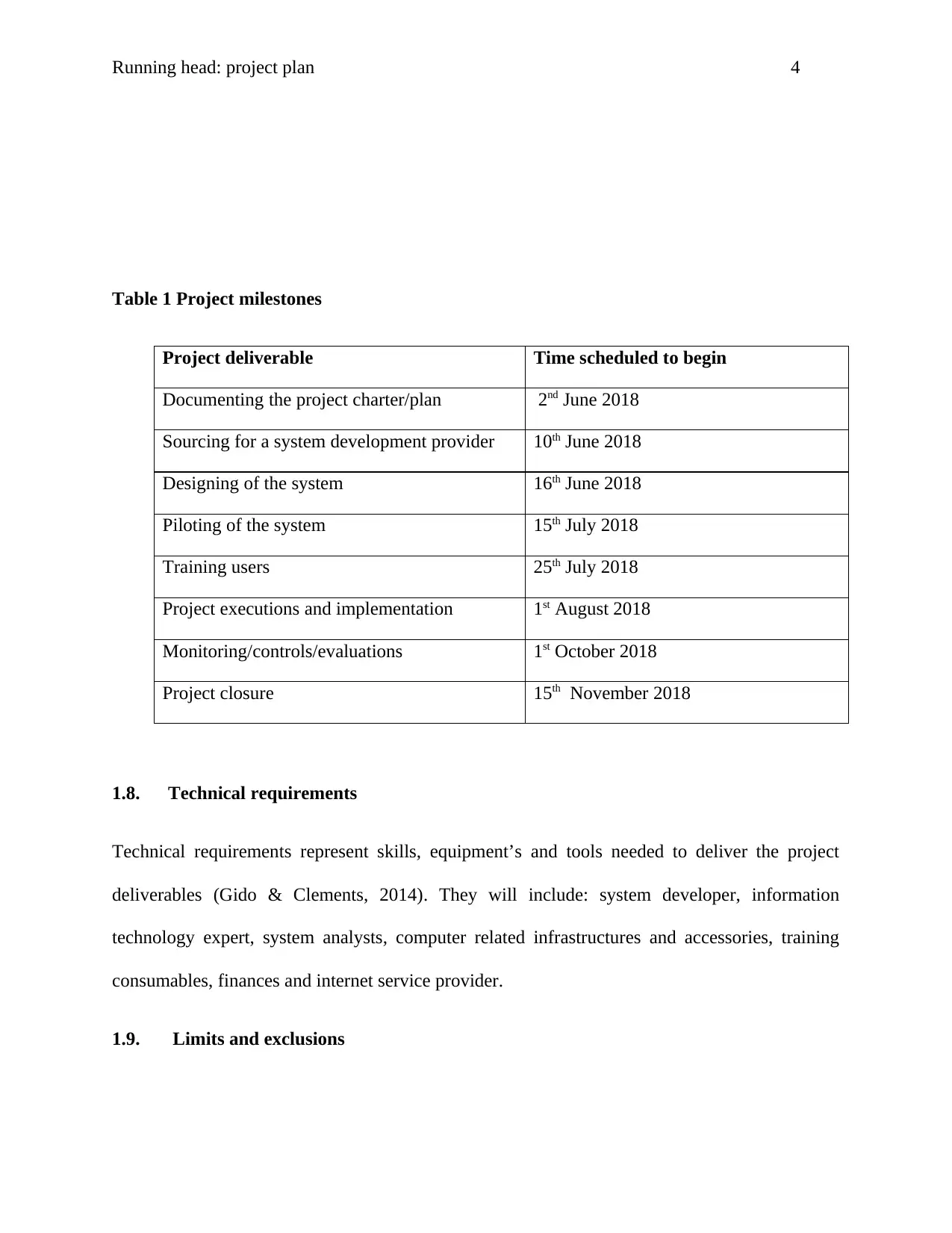
Running head: project plan 4
Table 1 Project milestones
Project deliverable Time scheduled to begin
Documenting the project charter/plan 2nd June 2018
Sourcing for a system development provider 10th June 2018
Designing of the system 16th June 2018
Piloting of the system 15th July 2018
Training users 25th July 2018
Project executions and implementation 1st August 2018
Monitoring/controls/evaluations 1st October 2018
Project closure 15th November 2018
1.8. Technical requirements
Technical requirements represent skills, equipment’s and tools needed to deliver the project
deliverables (Gido & Clements, 2014). They will include: system developer, information
technology expert, system analysts, computer related infrastructures and accessories, training
consumables, finances and internet service provider.
1.9. Limits and exclusions
Table 1 Project milestones
Project deliverable Time scheduled to begin
Documenting the project charter/plan 2nd June 2018
Sourcing for a system development provider 10th June 2018
Designing of the system 16th June 2018
Piloting of the system 15th July 2018
Training users 25th July 2018
Project executions and implementation 1st August 2018
Monitoring/controls/evaluations 1st October 2018
Project closure 15th November 2018
1.8. Technical requirements
Technical requirements represent skills, equipment’s and tools needed to deliver the project
deliverables (Gido & Clements, 2014). They will include: system developer, information
technology expert, system analysts, computer related infrastructures and accessories, training
consumables, finances and internet service provider.
1.9. Limits and exclusions
Paraphrase This Document
Need a fresh take? Get an instant paraphrase of this document with our AI Paraphraser
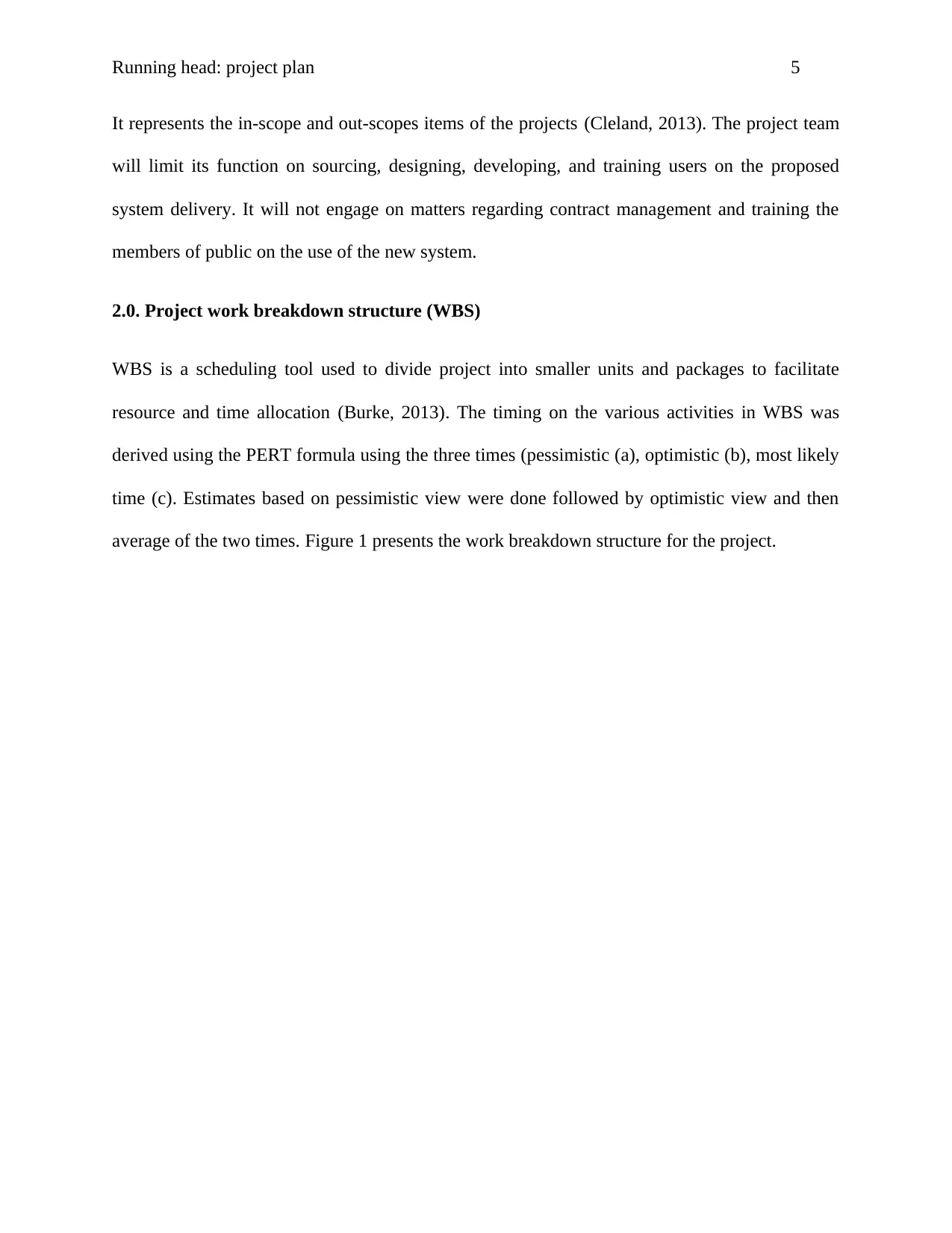
Running head: project plan 5
It represents the in-scope and out-scopes items of the projects (Cleland, 2013). The project team
will limit its function on sourcing, designing, developing, and training users on the proposed
system delivery. It will not engage on matters regarding contract management and training the
members of public on the use of the new system.
2.0. Project work breakdown structure (WBS)
WBS is a scheduling tool used to divide project into smaller units and packages to facilitate
resource and time allocation (Burke, 2013). The timing on the various activities in WBS was
derived using the PERT formula using the three times (pessimistic (a), optimistic (b), most likely
time (c). Estimates based on pessimistic view were done followed by optimistic view and then
average of the two times. Figure 1 presents the work breakdown structure for the project.
It represents the in-scope and out-scopes items of the projects (Cleland, 2013). The project team
will limit its function on sourcing, designing, developing, and training users on the proposed
system delivery. It will not engage on matters regarding contract management and training the
members of public on the use of the new system.
2.0. Project work breakdown structure (WBS)
WBS is a scheduling tool used to divide project into smaller units and packages to facilitate
resource and time allocation (Burke, 2013). The timing on the various activities in WBS was
derived using the PERT formula using the three times (pessimistic (a), optimistic (b), most likely
time (c). Estimates based on pessimistic view were done followed by optimistic view and then
average of the two times. Figure 1 presents the work breakdown structure for the project.
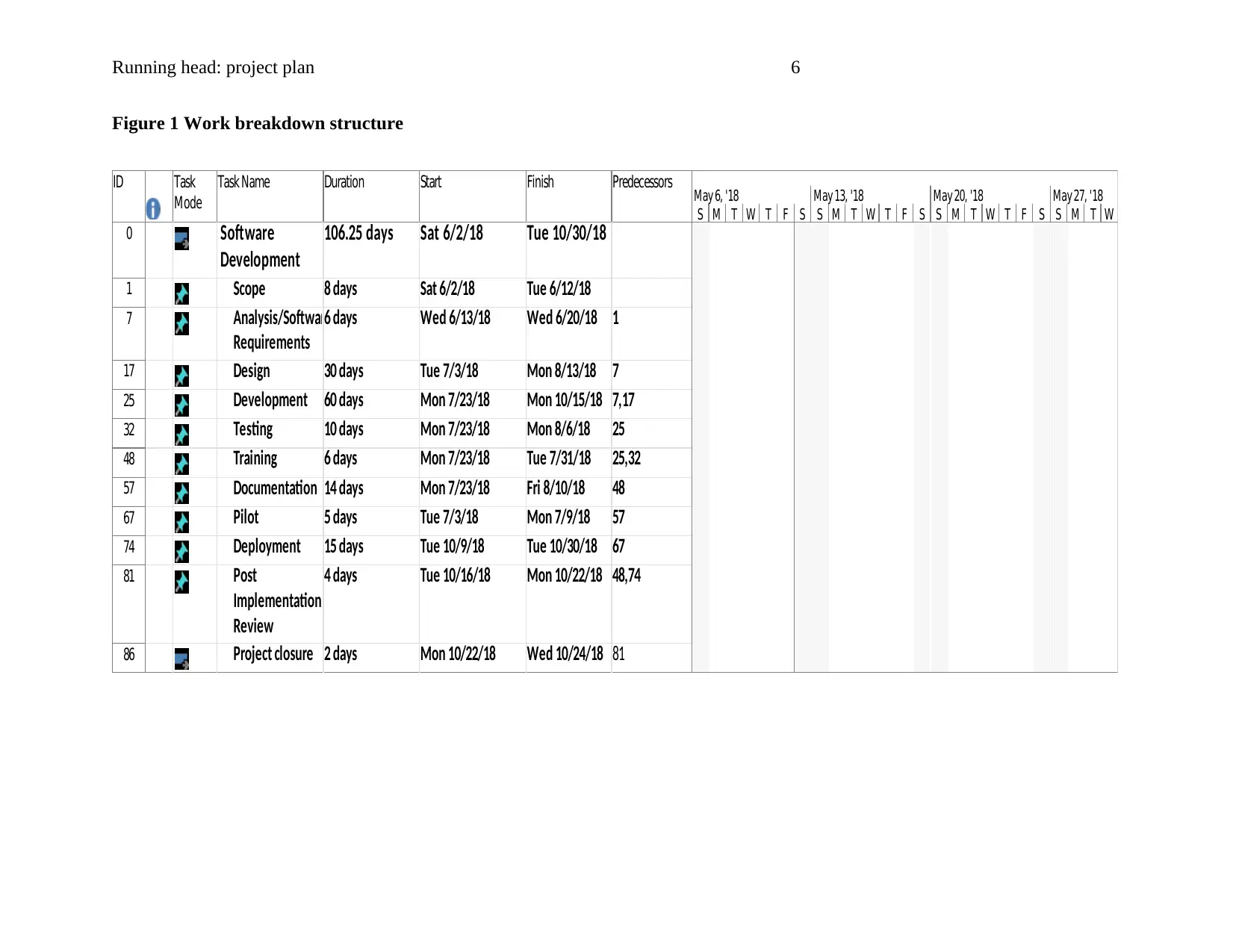
Running head: project plan 6
Figure 1 Work breakdown structure
ID Task
Mode
Task Name Duration Start Finish Predecessors
0 Software
Development
106.25 days Sat 6/2/18 Tue 10/30/18
1 Scope 8 days Sat 6/2/18 Tue 6/12/18
7 Analysis/Software
Requirements
6 days Wed 6/13/18 Wed 6/20/18 1
17 Design 30 days Tue 7/3/18 Mon 8/13/18 7
25 Development 60 days Mon 7/23/18 Mon 10/15/18 7,17
32 Testing 10 days Mon 7/23/18 Mon 8/6/18 25
48 Training 6 days Mon 7/23/18 Tue 7/31/18 25,32
57 Documentation 14 days Mon 7/23/18 Fri 8/10/18 48
67 Pilot 5 days Tue 7/3/18 Mon 7/9/18 57
74 Deployment 15 days Tue 10/9/18 Tue 10/30/18 67
81 Post
Implementation
Review
4 days Tue 10/16/18 Mon 10/22/18 48,74
86 Project closure 2 days Mon 10/22/18 Wed 10/24/18 81
S M T W T F S S M T W T F S S M T W T F S S M T W
May 6, '18 May 13, '18 May 20, '18 May 27, '18
Figure 1 Work breakdown structure
ID Task
Mode
Task Name Duration Start Finish Predecessors
0 Software
Development
106.25 days Sat 6/2/18 Tue 10/30/18
1 Scope 8 days Sat 6/2/18 Tue 6/12/18
7 Analysis/Software
Requirements
6 days Wed 6/13/18 Wed 6/20/18 1
17 Design 30 days Tue 7/3/18 Mon 8/13/18 7
25 Development 60 days Mon 7/23/18 Mon 10/15/18 7,17
32 Testing 10 days Mon 7/23/18 Mon 8/6/18 25
48 Training 6 days Mon 7/23/18 Tue 7/31/18 25,32
57 Documentation 14 days Mon 7/23/18 Fri 8/10/18 48
67 Pilot 5 days Tue 7/3/18 Mon 7/9/18 57
74 Deployment 15 days Tue 10/9/18 Tue 10/30/18 67
81 Post
Implementation
Review
4 days Tue 10/16/18 Mon 10/22/18 48,74
86 Project closure 2 days Mon 10/22/18 Wed 10/24/18 81
S M T W T F S S M T W T F S S M T W T F S S M T W
May 6, '18 May 13, '18 May 20, '18 May 27, '18
⊘ This is a preview!⊘
Do you want full access?
Subscribe today to unlock all pages.

Trusted by 1+ million students worldwide

Running head: project plan 7
3.0. Project Gantt chart and critical path
The Gantt chart represents a diagrammatical illustration of the project activities in reference to
time allocated to them (Bourne, 2015). It is derived from the work breakdown structure. The
critical path indicated in red represents the shortest time to achieve the desired outcome. Figure 2
and 3 shows Gantt chart 1 and critical path method for the project.
3.0. Project Gantt chart and critical path
The Gantt chart represents a diagrammatical illustration of the project activities in reference to
time allocated to them (Bourne, 2015). It is derived from the work breakdown structure. The
critical path indicated in red represents the shortest time to achieve the desired outcome. Figure 2
and 3 shows Gantt chart 1 and critical path method for the project.
Paraphrase This Document
Need a fresh take? Get an instant paraphrase of this document with our AI Paraphraser
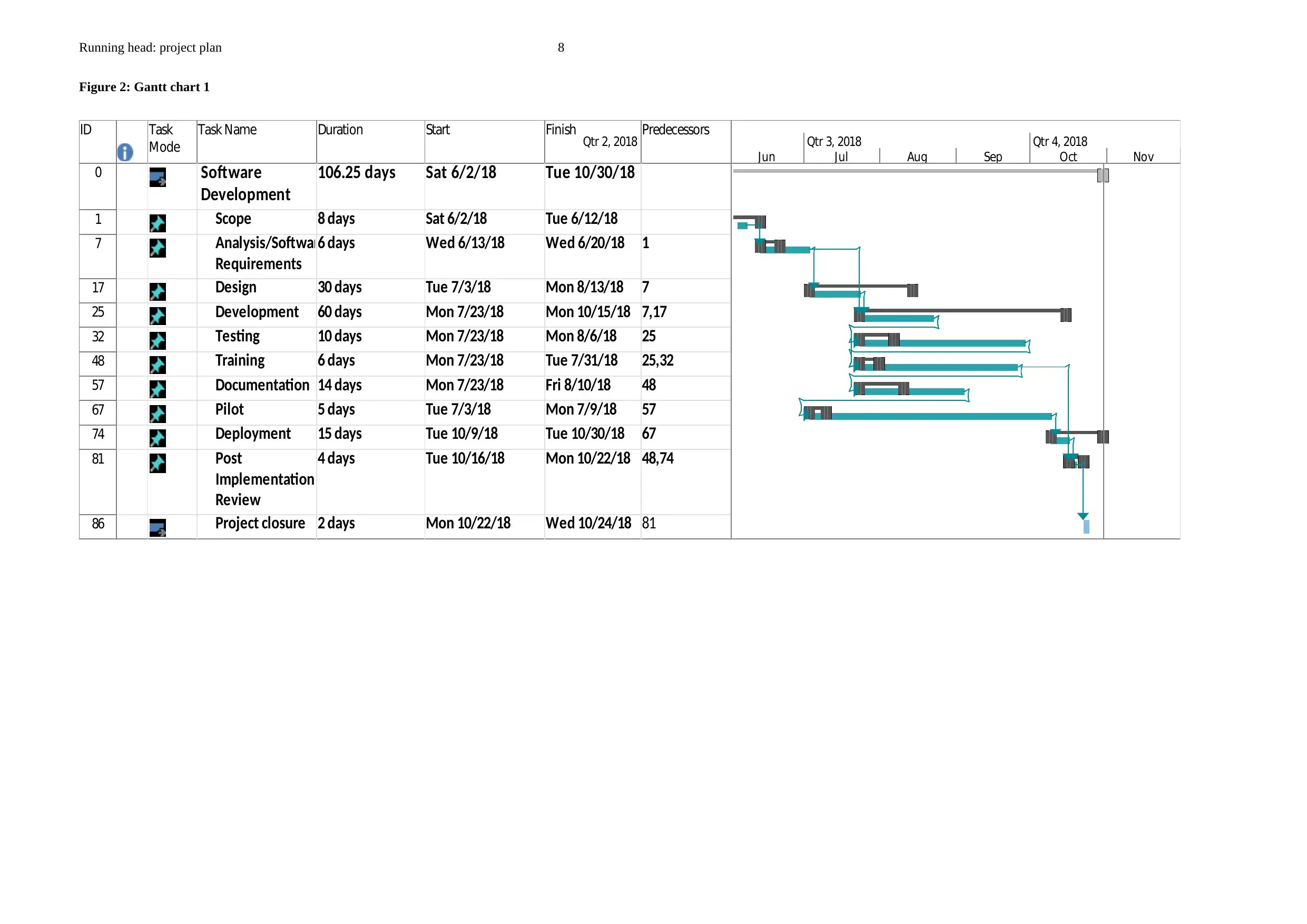
Running head: project plan 8
Figure 2: Gantt chart 1
ID Task
Mode
Task Name Duration Start Finish Predecessors
0 Software
Development
106.25 days Sat 6/2/18 Tue 10/30/18
1 Scope 8 days Sat 6/2/18 Tue 6/12/18
7 Analysis/Software
Requirements
6 days Wed 6/13/18 Wed 6/20/18 1
17 Design 30 days Tue 7/3/18 Mon 8/13/18 7
25 Development 60 days Mon 7/23/18 Mon 10/15/18 7,17
32 Testing 10 days Mon 7/23/18 Mon 8/6/18 25
48 Training 6 days Mon 7/23/18 Tue 7/31/18 25,32
57 Documentation 14 days Mon 7/23/18 Fri 8/10/18 48
67 Pilot 5 days Tue 7/3/18 Mon 7/9/18 57
74 Deployment 15 days Tue 10/9/18 Tue 10/30/18 67
81 Post
Implementation
Review
4 days Tue 10/16/18 Mon 10/22/18 48,74
86 Project closure 2 days Mon 10/22/18 Wed 10/24/18 81
Jun Jul Aug Sep Oct Nov
Qtr 2, 2018 Qtr 3, 2018 Qtr 4, 2018
Figure 2: Gantt chart 1
ID Task
Mode
Task Name Duration Start Finish Predecessors
0 Software
Development
106.25 days Sat 6/2/18 Tue 10/30/18
1 Scope 8 days Sat 6/2/18 Tue 6/12/18
7 Analysis/Software
Requirements
6 days Wed 6/13/18 Wed 6/20/18 1
17 Design 30 days Tue 7/3/18 Mon 8/13/18 7
25 Development 60 days Mon 7/23/18 Mon 10/15/18 7,17
32 Testing 10 days Mon 7/23/18 Mon 8/6/18 25
48 Training 6 days Mon 7/23/18 Tue 7/31/18 25,32
57 Documentation 14 days Mon 7/23/18 Fri 8/10/18 48
67 Pilot 5 days Tue 7/3/18 Mon 7/9/18 57
74 Deployment 15 days Tue 10/9/18 Tue 10/30/18 67
81 Post
Implementation
Review
4 days Tue 10/16/18 Mon 10/22/18 48,74
86 Project closure 2 days Mon 10/22/18 Wed 10/24/18 81
Jun Jul Aug Sep Oct Nov
Qtr 2, 2018 Qtr 3, 2018 Qtr 4, 2018
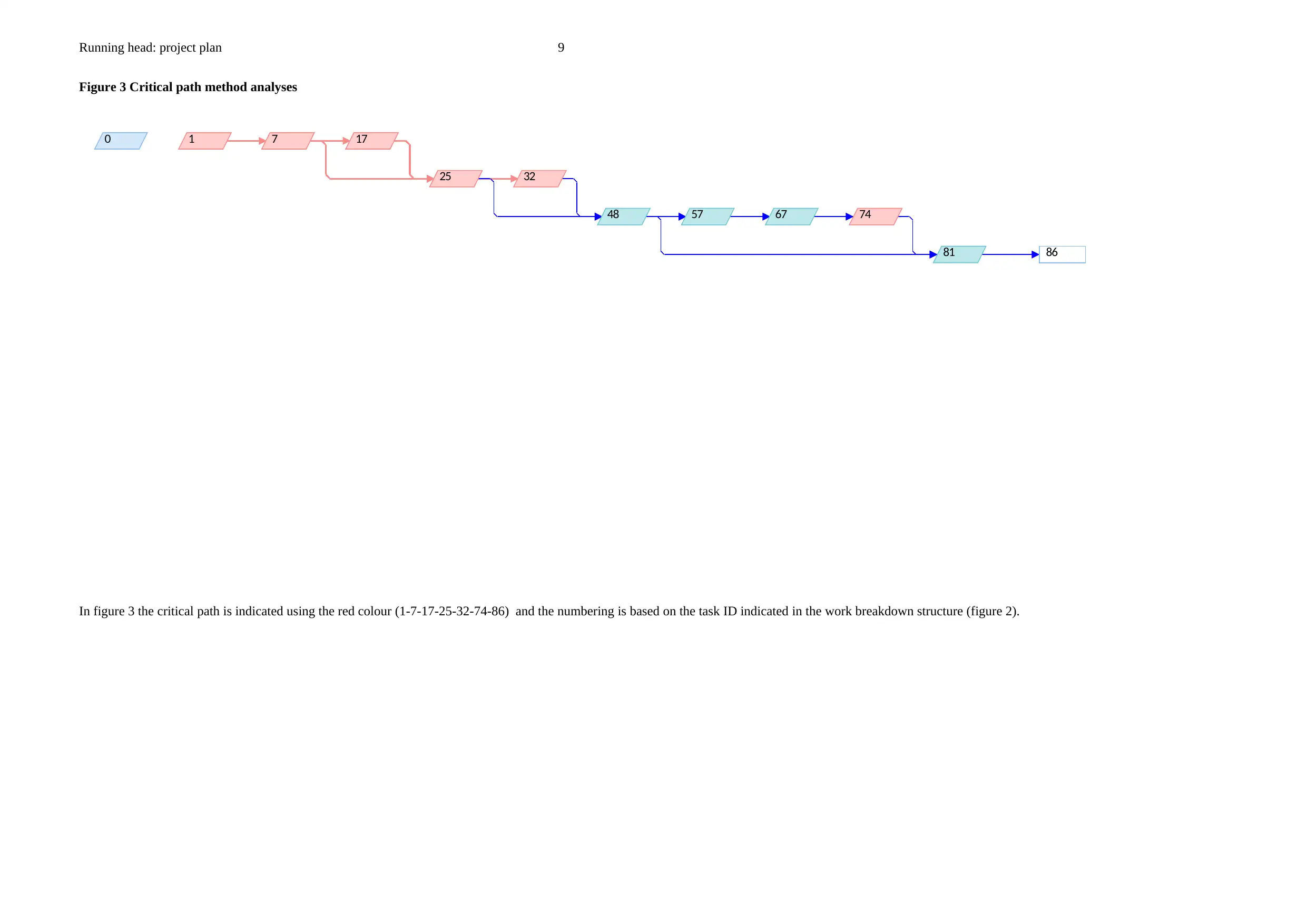
Running head: project plan 9
Figure 3 Critical path method analyses
1 7 17
25 32
48 57 67 74
86
0
81
In figure 3 the critical path is indicated using the red colour (1-7-17-25-32-74-86) and the numbering is based on the task ID indicated in the work breakdown structure (figure 2).
Figure 3 Critical path method analyses
1 7 17
25 32
48 57 67 74
86
0
81
In figure 3 the critical path is indicated using the red colour (1-7-17-25-32-74-86) and the numbering is based on the task ID indicated in the work breakdown structure (figure 2).
⊘ This is a preview!⊘
Do you want full access?
Subscribe today to unlock all pages.

Trusted by 1+ million students worldwide

Running head: project plan 10
4.0. Risk management
Project risk management defines the procedure followed to ensure that uncertainties are
identified, assessed and mitigated (Andrew, 2014). The risk management begins with
identification of risks affecting the project. Examples of risks identified include: A= Systems
collapse, B= Non-synchronization with other devices, C= Changes in technology, and D=
Resistance to change among the users
Once the risks have been identified an assessments would be done using the probability/impact
matrix in order to ranking to take place (Bryde, Broquetas & Volm , 2013). Table 2 shows the
probability/impact matrix.
Table 2 probability/impact matrix
Impact
High
Medium
low
Probability low medium high
From table 2 the ranking is summarized as follows: C, B, A, D
Ranking facilitates mitigation measures which are achieved using a risk management register
shown in Table 3. Risks affect project schedule (delays, contingencies, and lag times) strategies
should be put in place to ensure risks do not affect final outcome. Figure 3 (Gantt 2) shows
changes in the Gantt chart to reflect risk treatment strategy.
D A C
B
4.0. Risk management
Project risk management defines the procedure followed to ensure that uncertainties are
identified, assessed and mitigated (Andrew, 2014). The risk management begins with
identification of risks affecting the project. Examples of risks identified include: A= Systems
collapse, B= Non-synchronization with other devices, C= Changes in technology, and D=
Resistance to change among the users
Once the risks have been identified an assessments would be done using the probability/impact
matrix in order to ranking to take place (Bryde, Broquetas & Volm , 2013). Table 2 shows the
probability/impact matrix.
Table 2 probability/impact matrix
Impact
High
Medium
low
Probability low medium high
From table 2 the ranking is summarized as follows: C, B, A, D
Ranking facilitates mitigation measures which are achieved using a risk management register
shown in Table 3. Risks affect project schedule (delays, contingencies, and lag times) strategies
should be put in place to ensure risks do not affect final outcome. Figure 3 (Gantt 2) shows
changes in the Gantt chart to reflect risk treatment strategy.
D A C
B
Paraphrase This Document
Need a fresh take? Get an instant paraphrase of this document with our AI Paraphraser

Running head: project plan 11
Table 3 Risk register
Rank Type of risk Risk definition Causal factor Mitigation
measures
Responsible
person
Probability Impact
1 Changes in
technology (C)
Technology is
dynamic affecting
systems
Technology makes the
current systems
obsolete
Development of
systems that can be
upgraded in future
Systems
developer
High High
2 Non-
synchronization
with other
devices (B)
The system new
system can fail to
perform with other
devices
If the software was not
developed to
accommodate other
devices utility
Proper testing with
other devices needs
to be done
System analyst high Medium
3 System
collapse (A)
The system can
collapse
If proper design and
execution was not done
well
Proper
development and
execution need to
be done
Project
management
team
Medium High
4 Resistance
from users (D)
They may refuse to
utilize the new
service
Lack of ownership of
the users
Poor trainings and
consultations
Project
management
team
Low high
Table 3 Risk register
Rank Type of risk Risk definition Causal factor Mitigation
measures
Responsible
person
Probability Impact
1 Changes in
technology (C)
Technology is
dynamic affecting
systems
Technology makes the
current systems
obsolete
Development of
systems that can be
upgraded in future
Systems
developer
High High
2 Non-
synchronization
with other
devices (B)
The system new
system can fail to
perform with other
devices
If the software was not
developed to
accommodate other
devices utility
Proper testing with
other devices needs
to be done
System analyst high Medium
3 System
collapse (A)
The system can
collapse
If proper design and
execution was not done
well
Proper
development and
execution need to
be done
Project
management
team
Medium High
4 Resistance
from users (D)
They may refuse to
utilize the new
service
Lack of ownership of
the users
Poor trainings and
consultations
Project
management
team
Low high

Running head: project plan 12
Figure 3 (Gantt chart 3)
ID Task
Mode
Name Duration Start Finish Successors
0 Software Development 106.25 days?Sat 6/2/18 Tue 10/30/18
1 Scope 8 days Sat 6/2/18 Tue 6/12/18 7
7 Analysis/Software
Requirements
6 days Wed 6/13/18 Wed 6/20/18 17,25
17 Design 30 days Tue 7/3/18 Mon 8/13/18 25
25 Development 60 days Mon 7/23/18 Mon 10/15/18 32,48
32 Testing 10 days Mon 7/23/18 Mon 8/6/18 48
48 Training 6 days Mon 7/23/18 Tue 7/31/18 57,81
57 Documentation 14 days Mon 7/23/18 Fri 8/10/18 67
67 Pilot 5 days Tue 7/3/18 Mon 7/9/18 74
74 Deployment 15 days Tue 10/9/18 Tue 10/30/18 81
81 Post Implementation
Review
4 days Tue 10/16/18 Mon 10/22/18 86
86 Project closure 2 days? Mon 10/22/18 Wed 10/24/18
6/20
8/6
7/31
10/ 22
Jun Jul Aug Sep Oct Nov
Qtr 2, 2018 Qtr 3, 2018 Qtr 4, 2018
The figure shows that certain time in milestones have been lagged behind in order to allow for contingency planning and creating more developments to ensure that consultation takes place. The pilot study is marked
red to indicate the risk potentiality of the deliverable.
Figure 3 (Gantt chart 3)
ID Task
Mode
Name Duration Start Finish Successors
0 Software Development 106.25 days?Sat 6/2/18 Tue 10/30/18
1 Scope 8 days Sat 6/2/18 Tue 6/12/18 7
7 Analysis/Software
Requirements
6 days Wed 6/13/18 Wed 6/20/18 17,25
17 Design 30 days Tue 7/3/18 Mon 8/13/18 25
25 Development 60 days Mon 7/23/18 Mon 10/15/18 32,48
32 Testing 10 days Mon 7/23/18 Mon 8/6/18 48
48 Training 6 days Mon 7/23/18 Tue 7/31/18 57,81
57 Documentation 14 days Mon 7/23/18 Fri 8/10/18 67
67 Pilot 5 days Tue 7/3/18 Mon 7/9/18 74
74 Deployment 15 days Tue 10/9/18 Tue 10/30/18 81
81 Post Implementation
Review
4 days Tue 10/16/18 Mon 10/22/18 86
86 Project closure 2 days? Mon 10/22/18 Wed 10/24/18
6/20
8/6
7/31
10/ 22
Jun Jul Aug Sep Oct Nov
Qtr 2, 2018 Qtr 3, 2018 Qtr 4, 2018
The figure shows that certain time in milestones have been lagged behind in order to allow for contingency planning and creating more developments to ensure that consultation takes place. The pilot study is marked
red to indicate the risk potentiality of the deliverable.
⊘ This is a preview!⊘
Do you want full access?
Subscribe today to unlock all pages.

Trusted by 1+ million students worldwide
1 out of 18
Related Documents
Your All-in-One AI-Powered Toolkit for Academic Success.
+13062052269
info@desklib.com
Available 24*7 on WhatsApp / Email
![[object Object]](/_next/static/media/star-bottom.7253800d.svg)
Unlock your academic potential
Copyright © 2020–2025 A2Z Services. All Rights Reserved. Developed and managed by ZUCOL.




